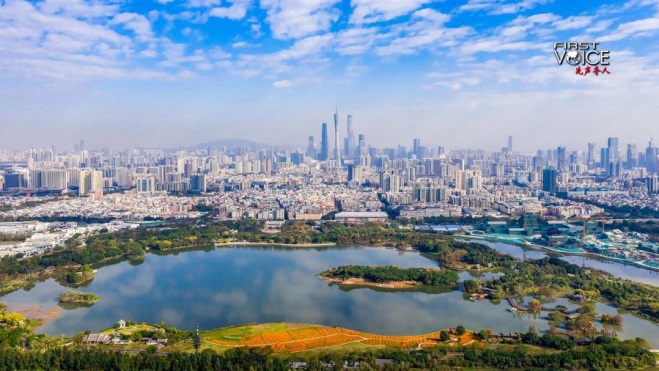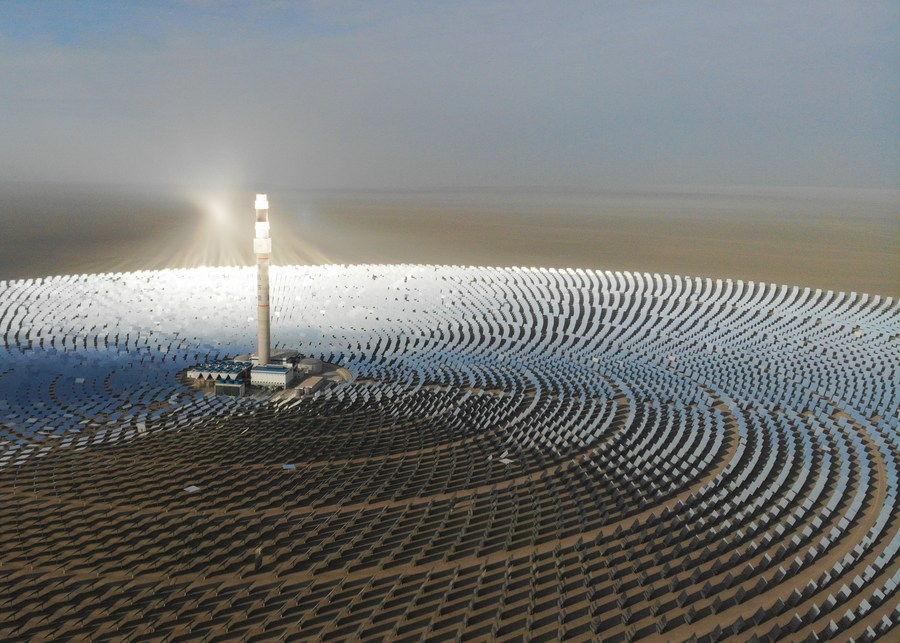
The Haizhu wetland and the Canton Tower in the distance in Guangzhou, south China's Guangdong Province. [Photo/Xinhua]
By Hu Tao
After earning my PhD from the Research Center for Eco-Environmental Sciences of the Chinese Academy of Sciences, I began working in the National Environmental Protection Agency in China in 1992, dedicating myself to protecting the environment. However, I felt powerless as an individual because I realized that no matter how hard I worked, I couldn't possibly stop all the pollution.
In 2012, in order to improve my analytical skills, I shifted my job in Beijing to work in Washington. During my time at the World Resources Institute (WRI), a renowned international think tank, there was frequent coverage of China's severe air pollution by the U.S. media.
Indeed, in the early stages after China launched its reform and opening-up in 1978, it adopted a growth-focused development approach at the expense of the environment to escape poverty, even though there were efforts to mitigate the impacts of pollution.
In 1978, China's per-capita electricity consumption was only 260 kilowatt-hours (kWh), and it wasn't until 2000 that it exceeded 1,000 kWh. Severe power shortages affected people's daily lives and hindered economic development, making it impossible to get rid of poverty. Given China's rich coal but limited oil reserves, coal-fired power was the only option back then, leading to severe air pollution and significant greenhouse gas emissions.
Ten years after moving to the U.S., I decided to return to China in 2023 to catch up with the fast growing renewable green energy development of China. Upon my return, I found myself in a familiar cultural community surrounded by green mountains and clear waters. In comparison to the severe smog of 10 years ago, the air has been becoming fresher and fresher.
In the meantime, thanks to China's growing green energy industry, the country's environmental improvement comes with increasing electricity consumption. By 2023, more than half of China's installed electricity capacity was from renewable energy. China's per capita annual electricity consumption had increased to 6,539 kWh, and the nation's total annual electricity consumption reached 9.22 trillion kWh, ranking it first in the world. It is also about double that of the U.S. total annual electricity consumption which ranked No.2 in the world.
Over the past decades, China's renewable energy development has grown from scratch to being a global leader. China produces 85 percent of the world's solar panels and over 90 percent of solar cells, and its wind energy capacity accounts for 60 percent of the global total.

A molten-salt solar thermal power plant in Dunhuang, northwest China's Gansu Province. [Photo/Xinhua]
The rapid development of renewable energy has reduced air pollutants and emissions, demonstrating China's commitment as a responsible major country. This achievement stems from China's effective practice of the "ecological civilization" philosophy, striving for green and sustainable development, resource conservation and environmental protection to build a resource-saving and environment-friendly society.
As the communique of the third plenary session of the 20th Central Committee of the Communist Party of China stated, "Chinese modernization is the modernization of harmony between humanity and nature. We must improve ecological conservation systems, make concerted efforts to cut carbon emissions, reduce pollution, pursue green development, boost economic growth, actively respond to climate change, and move faster to improve the systems and mechanisms for applying the principle that lucid waters and lush mountains are invaluable assets."
China has also integrated domestic air quality improvement with international greenhouse gas emission reductions, implementing coordinated control policies. The utilization of renewable energy is one of the most effective measures. China's Law on Air Pollution Prevention and Control calls for comprehensive measures to be taken to co-control particulate matter, sulfur dioxide, nitrogen oxides, volatile organic compounds, ammonia, and greenhouse gases.
China is a unique country to explicitly incorporate "co-control measures" into national legislation. While promoting green energy development domestically, China is also advancing its green Belt and Road Initiative, helping partner countries achieve green development and supporting other nations in fulfilling their Nationally Determined Contributions (NDCs) for greenhouse gas emission reductions.

The China-Laos railway over the villages and fields in northern Laos. [Photo/Xinhua]
However, as China vigorously promotes ecological civilization and actively reduces greenhouse gas emissions, some Western countries accuse China of overcapacity in the renewable energy sector. I witnessed the 28th session of the Conference of the Parties to the UN Framework Convention on Climate Change in Dubai in 2023, where one of the most important outcomes was the consensus that to achieve the 1.5 degree Celsius temperature goal, global installed renewable energy capacity needs to triple by 2030 compared to 2020.
China's installed renewable energy capacity was nearly 1 terawatt by the end of 2020 and 1.4 terawatts by October 2023. There is quite a gap to the 3 terawatt target by 2030, indicating a substantial demand for renewable energy. In 2023, the global renewable energy capacity was 3.87 terawatts, far short of the 11 terawatt target. This is not overcapacity, but a massive demand gap.
Therefore, some Western countries' accusations of overcapacity in China's renewable energy sector are bewildering. As repeatedly stated in classical economics textbooks, prices are determined by the market, achieving equilibrium between supply and demand. When there is excess supply, profits decrease, and supply reduces. Conversely, when there is insufficient supply, prices rise, prompting increased production until a new equilibrium is reached.
In the context of China's renewable energy development, with no exception, photovoltaic products' prices are also determined by supply and demand. If there were overcapacity, the market would adjust it automatically. Given the substantial global demand to meet the UN's target of tripling renewable energy capacity, China's renewable energy will be crucial to supply rather than being considered overcapacity.
As the communique released last week stated, China will prioritize ecological protection, conserve resources and use them efficiently, and pursue green and low-carbon development, with a view to promoting harmony between humanity and nature. China's green growth is pivotal to not only the country's sustainable development, but also the wellbeing of the world. My personal story illustrates the rapid progress of China's green energy industry and is a testament to the country's commitment to green development.
Hu Tao, a special commentator on current affairs for CGTN, is the president of the Lakestone Institute for Sustainable Development, and chairman of the Board of Professional Association for China's Environment.

 中文
中文



